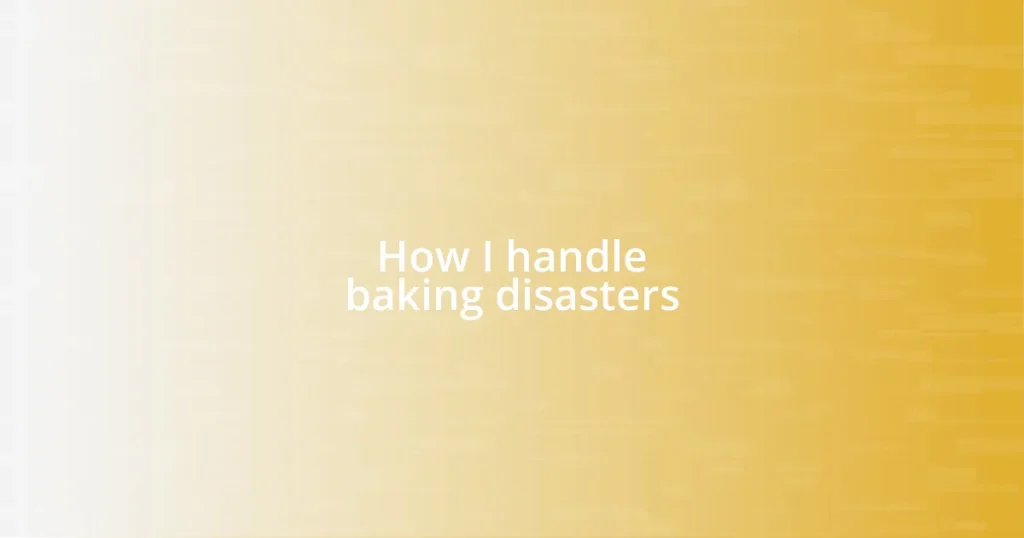Key takeaways:
- Baking disasters often stem from common mistakes like incorrect measurements, inconsistent oven temperatures, and overmixing, which serve as valuable learning experiences.
- Creative solutions for salvaging baking failures include using glazes, repurposing overbaked goods, and enhancing flavors to mask imperfections.
- Preparation and understanding one’s oven are crucial to preventing future mistakes, coupled with maintaining a baking journal for tracking successes and lessons learned.
- Sharing baking failures with others fosters connection and provides a supportive network, emphasizing that everyone faces mishaps in their culinary journeys.

Understanding baking disasters
Baking disasters are more common than you might think, and they can stem from a variety of factors, ranging from incorrect measurements to unexpected oven temperatures. I remember the first time I attempted to bake a soufflé; it felt like a monumental challenge. Unfortunately, my oven had other plans, and my beautiful, airy creation collapsed into a sad, flat puddle. Have you ever had that moment where you just stand there, staring at your failure, wondering where it all went wrong?
Each mishap often provides a deeper understanding of the baking process itself. For instance, when my chocolate cake turned out dry and crumbly, I realized that I had likely overmixed the batter. It’s like a slap in the face that teaches you about the importance of technique. What’s your most memorable baking lesson learned through failure? Sometimes, those lessons are what ultimately elevate our skills as bakers.
Baking is as much about chemistry as it is about creativity. An improperly adjusted recipe can lead to unexpected outcomes, making disasters a part of the journey. The first time my bread didn’t rise, I felt a mix of confusion and disappointment. But in retrospect, I learned to appreciate how important the role of yeast and temperature can be. It’s these moments that remind me to approach baking with curiosity and patience.

Common baking mistakes
There are several common mistakes that can lead to baking misfires. A seemingly simple error, like not preheating the oven, can dramatically alter how your dish turns out. I learned this the hard way one chaotic afternoon when I tried to hurry a batch of cookies. The result? Biscuits that were more like sugary pancakes. It’s a stark reminder that patience is key in baking.
Here’s a list of baking blunders I’ve encountered (and hopefully you can avoid):
- Incorrect Measuring: Using a liquid measuring cup for dry ingredients can throw off your ratios.
- Not Following the Recipe: Impulsively substituting ingredients can lead to unexpected flavors and textures. I once swapped baking powder for baking soda—big mistake!
- Oven Temperature Issues: Relying on the oven dial isn’t always accurate. Invest in an oven thermometer; trust me, it’s worth it.
- Overmixing the Batter: Mixing too much can lead to tough baked goods—my first attempt at muffins taught me that lesson the hard way.
- Ignoring Ingredients’ Room Temperature: Not letting eggs or butter sit out can affect how well they incorporate into your mix and can lead to dense cakes.
Each of these missteps has been a part of my journey in the kitchen, shaping my understanding and my approach. I look back on those moments with a blend of humor and nostalgia, knowing they’ve made me a better baker.

Steps to rescue overbaked goods
When your baked goods end up overcooked, it can feel disheartening, but don’t lose hope just yet. One of my go-to strategies is to cover the baked dish with a simple glaze or frosting. I once made a batch of overbaked brownies that were dry enough to resemble bricks. A quick chocolate glaze not only added moisture but also brought them back to life, transforming my disappointment into a decadent treat. Have you ever tried reviving a dessert this way? It can make all the difference!
Another method I often turn to is repurposing the overbaked goods. For instance, those once-dry cookies I made? I crumbled them up and repackaged them as ice cream toppings. It sounds a little unconventional, but the crunch added a delightful twist, elevating my dessert game unexpectedly. This adaptability reminds me that cooking is truly an art form. What creative ideas have you come up with in the kitchen?
Lastly, don’t underestimate the power of moisture. If a cake is overbaked, one trick I swear by is to brush it with simple syrup. This step not only revitalizes it but also gives a touch of sweetness that can enhance the flavor. I had a carrot cake once that baked a bit too long, and a quick soak transformed it from a dry mouthful to an enjoyable delight. It’s about being willing to take risks and learning to see potential in every baking challenge.
| Method | Description |
|---|---|
| Glaze or Frosting | Add a sweet topping to mask dryness and improve texture. |
| Repurposing | Transform baked goods into toppings or new recipes to avoid waste. |
| Moisture Addition | Use simple syrup to rehydrate dried cakes for better flavor. |

Fixing collapsed cakes
Fixing a collapsed cake can feel like a mini-disaster in the kitchen, but it doesn’t have to spell the end of your baking endeavors. When my half-baked sponge cake turned into a sad little puddle last summer, I found myself at a crossroads of despair and creativity. Instead of throwing it all out, I decided to layer it with whipped cream and fresh berries, transforming my flop into an elegant trifle. Have you ever turned a baking fail into something delightful? It’s a testament to how our mistakes can lead to unexpected beauty.
If a cake has collapsed and you’re still trying to salvage it, one quick fix is to simply embrace the crumble! I once had a cake so sunken that I transformed it into a cake pops extravaganza. With some chocolate coating and sprinkles, my dessert turned from kitchen sorrow to a fun party treat. It’s a valuable lesson I’ve learned: immediate reactions can sometimes lead to a new culinary adventure. Have you thought about how you might creatively repurpose a mishap?
Lastly, if you’re dealing with a collapsed cake while in a hurry, consider covering it with a luscious frosting that’s thicker than usual. I remember an incident where my chocolate cake sank right in the middle before a dinner party. To save face, I whipped up a rich ganache, pouring it generously over the top. The result was a visually stunning cake that made everyone forget its initial struggle. Don’t underestimate the power of a great topping to save the day—what’s your go-to frosting that can mask a little imperfection?

Tricks for salvaging burnt pastries
There’s nothing quite like the panic that sets in when you realize your pastries have taken a wrong turn towards burnt. I once mistakenly left a batch of almond croissants in the oven just a touch too long. Instead of tossing them out, I decided to slice off the charred edges and fill them with a luscious pastry cream. The transformation from despair to delight was incredible—I couldn’t help but think, have you ever salvaged something just by being a bit clever?
Another trick that I always reach for is adding a bit of crunch. I learned this the hard way with some overly crisp puff pastry. Instead of discarding them, I crumbled the burnt bits and mixed them with melted chocolate. The result? A unique cookie crumble that became the star of my next dessert parfait. This unexpected twist reminded me that, in baking, as in life, experimentation can yield delicious surprises. What have you discovered in your kitchen experiments that turned out better than you expected?
Finally, I can’t stress enough how important flavor balance can be when salvaging burnt pastries. The first time I burnt a batch of lemon bars, I was devastated. However, I decided to lemon curd the situation—literally. By adding a generous layer of fresh lemon curd on top, I was able to mask the bitterness of the burnt edges while enhancing the sweet-tart flavor of the bars themselves. It left me reflecting on how sometimes, adding a new element can completely change the narrative of a dish. Have you ever found that the solution was just a twist of flavor away?

Preventing future baking errors
When it comes to preventing future baking errors, I’ve learned that meticulous preparation is key. I remember the time I baked a batch of cookies that turned into a single giant mess on my baking sheet because I didn’t measure the ingredients accurately. Now, I always double-check my measurements and read the recipe thoroughly before getting started—it’s a small step that saves me big headaches later. Have you ever had a baking moment that could have been avoided with careful prep?
Additionally, I’ve discovered the importance of understanding my oven’s idiosyncrasies. After numerous attempts at achieving the perfect soufflé, only to face a deflated disappointment each time, I invested in an oven thermometer. It turned out my oven ran around 25 degrees hotter than the dial indicated! Now, I know exactly how to adjust my baking times and temperatures. What quirks have you noticed about your oven that could make or break your next bake?
Finally, I make it a habit to jot down notes after each baking session. There was a time when I couldn’t replicate my favorite brownie recipe because I hadn’t recorded a single modification I’d made. By tracking what worked and what didn’t, I’ve created a personalized baking journal that helps me learn from each mishap. It’s like having a trusted guide in my baking adventures. Have you ever considered keeping a baking diary to track your progress? It might just be the secret ingredient to your success!

Learning from your experiences
Learning from baking experiences has been a game changer for me. I vividly recall a time when my bread dough didn’t rise, leaving me puzzled and a bit disheartened. Instead of just tossing it aside, I took the opportunity to research yeast problems and discovered it was most likely a temperature issue. That newfound knowledge has been invaluable—it’s amazing how a little research can prevent future baking woes!
Reflecting on past mistakes is another powerful tool in my kitchen arsenal. Recently, I made a sponge cake that turned out dense and unforgiving. I felt frustrated at first, but then I decided to analyze each step and realized I had overworked the batter. Now, after every baking disaster, I make it a point to dissect what went wrong. I encourage you to do the same; you might be surprised at how much insight you gain by just pausing to reflect. What have you learned from your own baking blunders?
I find that sharing my culinary failures with friends is also a rewarding experience. There was one particular occasion when my soufflé collapsed, and I couldn’t help but laugh it off with my friends over coffee. They shared their own tales of kitchen misadventures, and what surprised me was how relatable those stories were. It reminds me that we’re all on this cooking journey together, battling fire alarms and flour clouds. Isn’t it comforting to connect with others over our less-than-perfect baking experiences?















